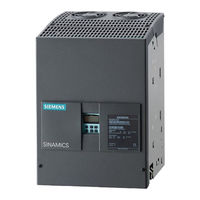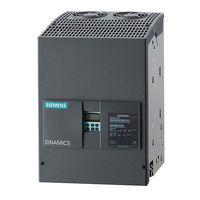Siemens SINAMICS DC MASTER Control Module Manuals
Manuals and User Guides for Siemens SINAMICS DC MASTER Control Module. We have 2 Siemens SINAMICS DC MASTER Control Module manuals available for free PDF download: Operating Instructions Manual
Siemens SINAMICS DC MASTER Operating Instructions Manual (759 pages)
Brand: Siemens
|
Category: Media Converter
|
Size: 35.29 MB
Table of Contents
-
Installation79
-
EMC Planning97
-
Field Supply145
-
Line Reactors148
-
Power Unit171
-
Memory Card Slot187
-
Mac Address195
-
Installation199
-
Technical Data199
-
Technical Data222
-
Terminal Type228
-
Installation233
-
Technical Data237
-
Terminal Type242
-
Installation253
-
Technical Data256
-
Installation267
-
Field Weakening280
-
Brake Control307
-
Operation351
-
Access Level354
-
Using Data Sets358
-
Drive Objects359
-
Operation371
-
Status Display375
-
Value Display377
-
Setting Options385
-
AOP Settings389
-
Date Format393
-
LOCAL/REMOTE Key395
-
AOP Setpoint398
-
Analog Inputs406
-
Analog Outputs407
-
Task Description451
-
Basic Procedure452
-
Bus Connector458
-
Media Redundancy501
-
Topology Rules506
-
Profinet Gsdml507
-
Sending Data518
-
Receiving Data520
-
Mapping Tables542
-
Specification553
-
Setpoint Channel560
-
Control Signals562
-
Fixed Setpoint567
-
Speed Controller570
-
Standard Mode606
-
Operating Modes614
-
Bus Connection630
-
Trace Function644
-
Single Trace644
-
Fault Buffer653
-
General Remarks663
-
Maintenance687
-
Replacing Fuses700
-
Diagnostics Test724
Advertisement
Siemens SINAMICS DC MASTER Operating Instructions Manual (715 pages)
Control Module
Brand: Siemens
|
Category: Control Unit
|
Size: 28.91 MB
Table of Contents
-
Field Supply114
-
Line Reactors114
-
Memory Card Slot142
-
Firing Pulse150
-
Ribbon Cables152
-
Mac Address161
-
Installation165
-
Technical Data165
-
Technical Data188
-
Terminal Type194
-
Installation199
-
Connector Coding202
-
Technical Data203
-
Terminal Type208
-
Installation219
-
Technical Data222
-
Installation233
-
Field Weakening246
-
Brake Control274
-
Operation319
-
Access Level322
-
Drive Objects327
-
Status Display343
-
Value Display345
-
Setting Options353
-
AOP Settings357
-
Date Format361
-
AOP Setpoint366
-
Analog Inputs374
-
Analog Outputs375
-
Task Description419
-
Basic Procedure420
-
Bus Connector426
-
Media Redundancy469
-
Topology Rules474
-
Profinet Gsdml475
-
Sending Data486
-
Receiving Data488
-
Mapping Tables510
-
Specification521
-
Setpoint Channel528
-
Control Signals530
-
Fixed Setpoint535
-
Speed Controller538
-
Standard Mode568
-
Operating Modes576
-
Bus Connection592
-
Trace Function606
-
Single Trace606
-
Fault Buffer615
-
Simulation Mode621
-
General Remarks627
-
Maintenance651
-
Diagnostics Test680
Advertisement

